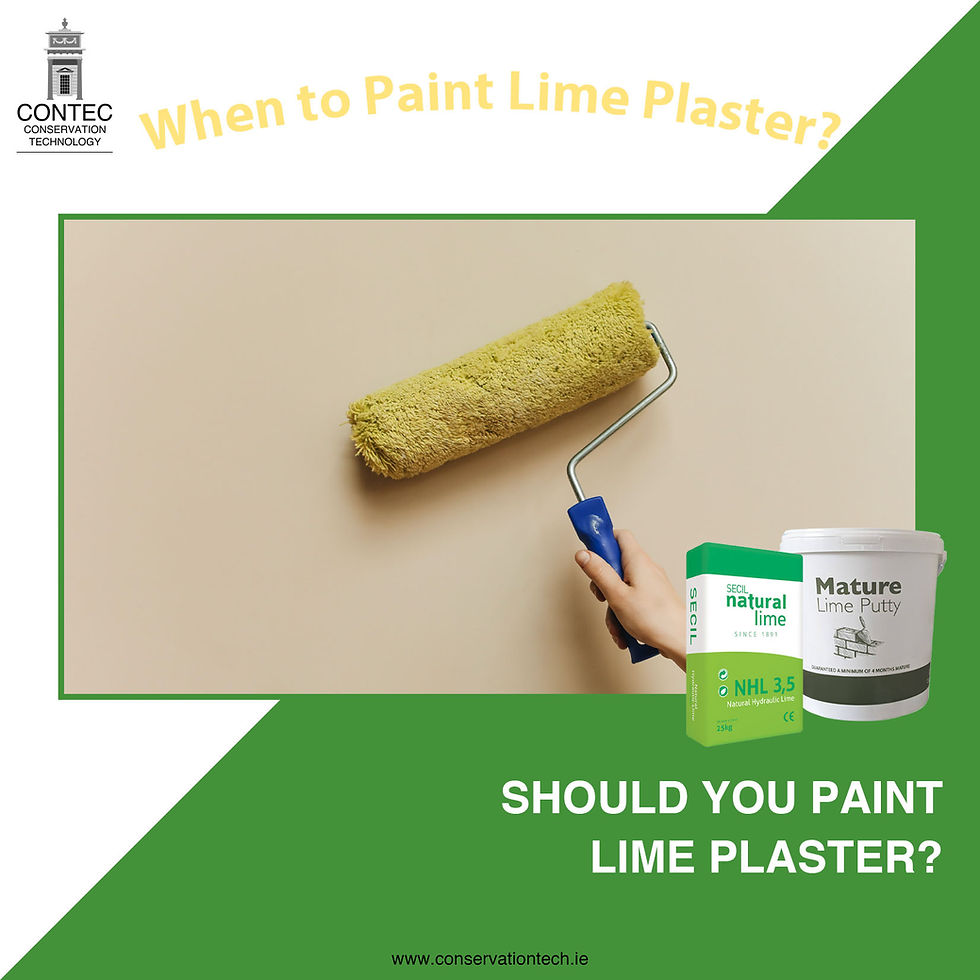When Can You Paint Over Fresh Lime Plaster?
- Conservation Technology
- Aug 15, 2023
- 3 min read
Updated: Aug 16, 2023
Hydraulic Lime & Non-Hydraulic Lime Painting

What is Lime Plaster?
Lime plaster is produced through the combination of either hydraulic or non-hydraulic lime (such as fat lime or lime putty) with diverse sands, aggregates, and water. This mixture finds frequent application in traditional construction, serving as an alternative to contemporary cement-based plasters and renders. Its highly regarded attributes include breathability, flexibility, and its capacity to safeguard the applied building, wall, or ceiling.
In certain instances, fibers are incorporated into lime plasters to bolster tensile strength. In the United Kingdom's historical context, horse and goat hair have predominantly been employed. Horse hair is chiefly utilized in foundational plasters, proving especially advantageous when lime plaster is used on laths due to the augmented strength it imparts.
On the other hand, goat hair possesses a finer texture, making it a preferred choice for finishing plasters. Many individuals appreciate the additional textural dimension that hair contributes. While horse hair is more commonly employed in scenarios necessitating strength, such as lath-related tasks, a final touch can involve a surface adorned with an unhairlined fine lime skim plaster.

When Can You Paint Over Fresh Lime Plaster?
For the majority of paints, it is imperative that lime plaster attains complete curing and drying prior to application. The reason behind this requirement is that any remaining moisture within the plaster, when it hasn't achieved full curing, can lead to issues like peeling, bubbling, or other forms of paint failure. Notably, among paints, limewash stands as an exception, capable of being employed before the plaster's full curing. Generally, the rule would be to allow for 4 weeks for every 5mm of thickness that is applied but in poor drying conditions it can take longer. For clay paint you would expct to wait from 4-6weeks and for silicate paints yo can expect to wait 6-8weeks before painting. For certain hydraulic lime plasters such as EcoCork plaster, can be painted after a few to a week.
Limewash possesses the unique characteristic of being applicable prior to the plaster's complete curing process, even during its 'green' state. In this context, 'green' signifies that the surface of the plaster is solidified, albeit it may still retain slight dampness or remain incompletely cured. This exceptional capability arises due to the vapor-permeable nature shared by both limewash and lime plaster.
Consequently, this arrangement facilitates simultaneous curing of both the paint and the plaster. It is worth noting that the act of limewashing a lime plaster surface prior to its full curing can induce a subtle dyeing effect on the plaster. This often results in the creation of exceptionally attractive and richer hues.

What Paints can be Used on Lime Plaster?
Lime plaster is characterized by its vapor-permeable nature, enabling it to absorb moisture from within the wall and gradually transport it to the surface, facilitating evaporation without causing harm. Preserving this process without obstruction or sealing is crucial.
Hence, it is imperative to opt for vapor-permeable or breathable paints when working with lime plaster. Paints that possess waterproofing, water resistance, or surface-sealing properties are incompatible with lime plaster. So, what types of paints are most suitable for use alongside lime plaster?
Lime-based paints typically rank as the top choice for lime plaster. This category encompasses both lime paint and limewash, each representing distinct paint varieties. Furthermore, other natural and breathable paint options, such as clay paint, mineral paint, and distemper, can also be employed effectively.

Our Breathable Paint Range:
Remmers Color LA (Exterior)
Remmers Color SH (Exterior)
Earthborn Silicate Masonry Paint (Exterior)
Earthborn Clay Paint (Interior)
Earthborn EcoPro Matt Emulsion (Interior)
Remmers Color Si (Interior)
See more about premium paint range below:







Commentaires